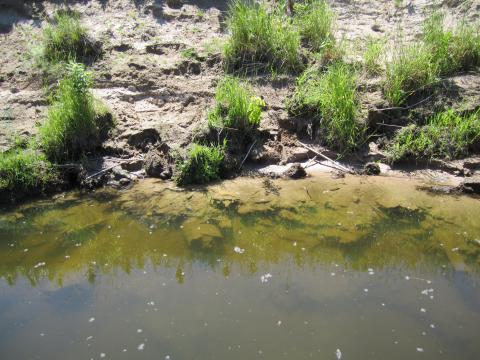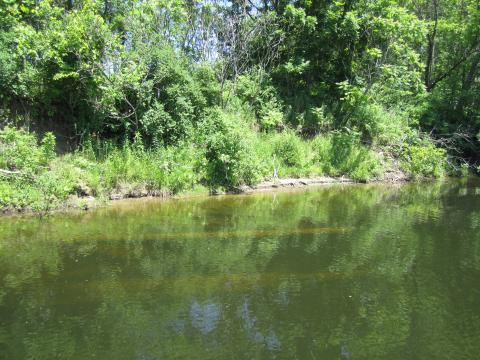• Holocene riparian forest at the Oneida watershed, NY
• Records of extreme flooding at Fish Creek, NY
With help of the Hamilton College Dept. of Geosciences pontoon research vessel we traversed several kilometers of Fish Creek just upstream from its mouth at Sylvan Beach, NY, on the eastern flank of Oneida Lake, and sampled 52 logs. Along this stretch we sampled three locations with abundant wood, designated as Sites #1 (43°13.61′N, 75°40.947′W, 114 m a.s.l.), #2 (43°13.699′N, 75°41.232′W 111 m a.s.l.) and #3 (43°12.974′N, 75°42.479′W, 108 m a.s.l.) (Fig.). Fifteen, 25 and 12 samples were obtained from the three sites, respectively, at positions both just above and just below the water level. Logs at Site 1 were mainly situated in a peaty muck layered with yellowish brown sand. At Sites 2 and 3, the logs were found buried in a yellowish brown sandy silt of the modern riverbank. Radiocarbon ages and successful tree-ring crossdating document what we interpret as seven major hydrologic episodes ca. 10 ka (i.e. ca. 10,000 cal yr BP), 7.4 ka, 6.8 ka, 6.4 ka, 5.5 ka, 3.1 ka and 2.2 ka BP, during which channel aggradation and tree burial may have been associated with abruptly increased flood frequency and/or high water tables. This pilot study establishes four floating tree-ring records: [1] early Holocene hemlock (Tsuga), mid-Holocene [2] walnut (Juglans sp.) and [3] sycamore (Platanus), and [4] late Holocene elm (Ulmus sp.), with sample sizes of 8-14 series of 55-135 years length. Despite complexity of distribution of radiocarbon ages at each site, the wealth of well-preserved wood demonstrates great promise for understanding paleoflood history of the Oneida watershed by documenting magnitude, location, and timing of floods. Glacial deposition and fluvial/lacustrine sedimentation interact over terrains in central New York State to preserve a history of geological and hydrological events as well as hydroclimatic transitions. Reference: Panyushkina I.P., Leavitt S.W., Domack E.W., Wiedenhoeft A.C., 2015. Tree-ring investigation of Holocene flood-deposited wood from the Oneida Lake watershed, New York State. Tree-Ring Research 71(2): 83-94.



